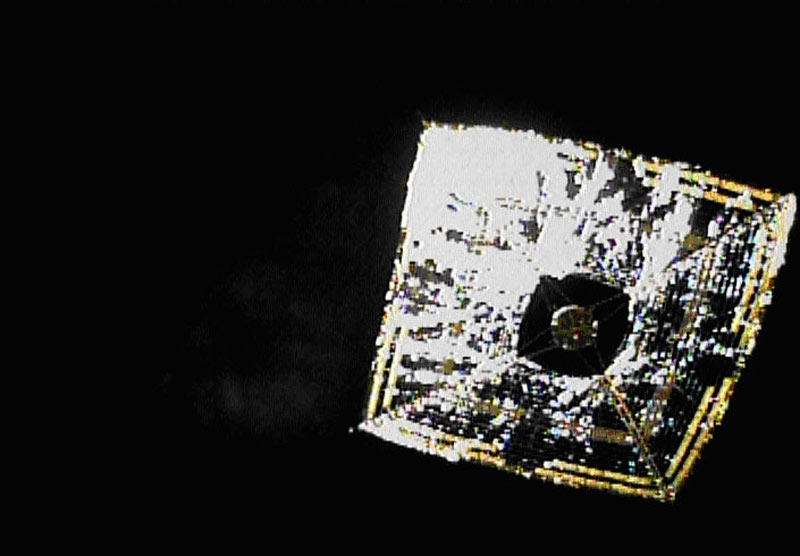Solar Sail Spacecraft Steers with Sunlight for First Time

Japan'ssolar sail ? a sun-powered spacecraft launched in May ? hassuccessfullysteered by using just the pressure of sunlight against its squarepolymer sail,Japan space officials said.
The JapanAerospace Exploration Agency spacecraft Ikaros now representsthe first solar sailto have harnessedsunlight for bothattitude control andpropulsion, after it first launched May 21 alongside the Venus-boundorbiterAkatsuki.
Liquidcrystal panels on the edges of the sail can change their surfacereflection ofsunlight by using low amounts of electricity to turn on or off. The"on" setting creates a mirror-like reflection that pushes thespacecraft forward, while the "off" setting has a more diffusereflectionthat redirects the pressure of sunlight in all directions, lesseningthe forceagainst the sail.
That allowsIkaros to slowly change direction based upon the different pressures ofsunlight reflecting from its edges. Mission controllers have to accountfor thesolar sail's spin rate, distance to the sun and the sun angle to plot thespacecraft's course.
An almostday-long test of the steering took place between the early morninghours ofJuly 13 and July 14. Mission controllers achieved more than 90 percentof theirexpected attitude control angle.
"JAXAwill continue the attitude control experiment by the Ikaros to evaluatethedetails of the attitude control performance while continuing to conductresearch on attitude control technology using sunlight pressure as atechnologythat enables navigation for longer in time and further in distance by asolarsail," JAXA officials said in a recent statement.
That effortwas also briefly described last week at the second InternationalSymposium onSolar Sailing at the New York City College of Technology in Brooklyn,whereresearchers hailed the solar sail'ssuccess.
Get the Space.com Newsletter
Breaking space news, the latest updates on rocket launches, skywatching events and more!
Suchattitude control does not use any additional propellant, which may helpmakefuture solar sails more self-sufficient. Ikaros also relies uponthrusterslocated on its main body at the center of its sail to move around.
The solarsail also carries solar panels that have successfully generatedelectricity,even if it cannot use the solar-generated power for itself.
JAXAenvisions Ikaros as the first step toward a future solar sailmission to Jupiter andasteroids that couldfly in 2019 or 2020, said Junichiro Kawaguchi, JAXA program manager,during thesolar sail conference.
- Video: Japan Aims for Venus, Part 2
- World's First Solar SailPhotographed in Deep Space
- How Do Solar Sails Work?
Join our Space Forums to keep talking space on the latest missions, night sky and more! And if you have a news tip, correction or comment, let us know at: community@space.com.
Jeremy Hsu is science writer based in New York City whose work has appeared in Scientific American, Discovery Magazine, Backchannel, Wired.com and IEEE Spectrum, among others. He joined the Space.com and Live Science teams in 2010 as a Senior Writer and is currently the Editor-in-Chief of Indicate Media. Jeremy studied history and sociology of science at the University of Pennsylvania, and earned a master's degree in journalism from the NYU Science, Health and Environmental Reporting Program. You can find Jeremy's latest project on Twitter.










